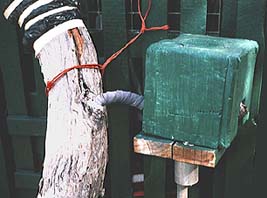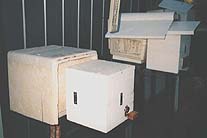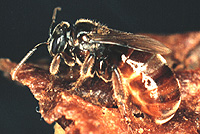Home
Aussie Bee Online
Welcome
New Articles
About Native Bees
Bee Photo Gallery
Bees in Your Area
Common Questions
Rescuing Native Bees
Exotic Bumblebees
What are Stingless Bees?
Buying Stingless Bees
Honey Production
Crop Pollination
Study Native Bees
Field Guide
Information Booklets
Tim Heard's Book
John Klumpp's Book
Aussie Bee Back Issues
Seminars
Links
Support Native Bees
Aussie Bee Shop
Order Form
Who We Are
Donations
Privacy Policy
Free Newsletter
Website Survey
Download Printer-Friendly PDF version of this article
Natural Hive Duplication (or Eduction):
An Alternative Method of Propagating Australian Stingless Bees
Dr Anne Dollin
Australian Native Bee Research Centre
November 2001
Natural Hive Duplication is an alternative method of propagating stingless native bees which is gaining much support amongst Australian beekeepers. (Note: since 2007 John Klumpp's term for this method, 'Eduction', has become quite widely used.)
The Australian stingless bees (genera Trigona and Austroplebeia) produce new nests in a way that is quite different from that used by commercial honey bees (Apis mellifera):
- In honey bees the old mature queen suddenly leaves the original nest with a huge swarm of worker bees. Scout bees locate a suitable empty cavity inside a hollow tree or in a building. Then the whole swarm moves in and begins constructing a new nest.
- In the stingless native bees, worker bees spend many weeks gradually constructing a new nest inside a nearby hollow tree. Then when the nest is nearly finished a young, newly mated queen moves in with some worker bees to complete the new nest.
In honey bees, the beekeeper may start a new hive simply by catching a swarm (including the workers and the old mature queen) and placing it in an empty bee hive. This does not work with Trigona stingless bees; so beekeepers have developed other methods of propagating stingless bee hives.
Methods of Propagating Stingless Bees
The quickest and most widely used method is to physically split the hive into two parts. Full details of this Splitting Method are published in the following booklets in the Native Bees of Australia Series: Keeping Australian Stingless Bees in a Log or Box; and Boxing and Splitting Hives. See the Aussie Bee website for ordering details.
There is, however, an alternative method of propagating stingless native bees that is becoming increasingly popular with many beekeepers. Using this method, bees in a boxed hive can be persuaded to build a new hive in an adjoining empty box. The method can also be used to coax stingless bees into a box from a natural nest site in a large tree or an inaccessible cavity.
This method was first shown to us by Tom Carter of Rockhampton. We call this technique Natural Hive Duplication. Another name, proposed by John Klumpp of Brisbane, is the Eduction Method. Dr Tim Heard says that a similar process of nest formation occurs naturally in ants and scientists call it Budding.
 |
The Natural Hive Duplication Technique
The nest to be duplicated must be strong and active. Begin the technique in spring or summer when there are plenty of flowers available so that the bees can produce a new queen bee and gather stores for the new hive.
Use a standard empty hive box for stingless bees with an entrance hole drilled through the front panel (see the standard OATH box design in our booklet, Keeping Australian Stingless Bees in a Log or Box).
Drill another 20 mm hole in the back of the new hive box. Then place the new hive box as close as possible to the original nest entrance.
Use a plastic tube to connect the original nest entrance to the hole in the back of the new hive box. All bees leaving the original nest must be forced to walk into the new hive box and out through its entrance hole. Take great care to completely seal all gaps between the tube, the original nest and the new hive box so that the bees cannot escape from the tube without going through the new hive box. If the tube is transparent cover it with cloth or tape to keep out the light.
Over a few months the bees should begin building a second nest inside the new hive box. The original nest will still remain in its original cavity. When the new hive is well established, separate it from the original nest and move it to a new location.
If the bees are reluctant to begin constructing the new nest, Tom Carter recommended that a small piece of brood comb (about two layers thick and the size of a small saucer) should be placed in the new hive box. This ‘catalyst brood’ often encourages them to begin building.
In What Situations Does Natural Hive Duplication Work?
On our Aussie Bee research trips we have seen this Natural Hive Duplication method successfully used by many beekeepers. Les Felhaber of Rockhampton had a Trigona hockingsi nest in a cavity at the base of a house pier. He was successfully encouraging this nest to build in a series of new hive boxes. Rob Raabe of Ipswich showed us a large log nest of Trigona carbonaria which was building a new nest in an attached hive box. Lee Byrnes had sealed an empty hive box on top of a Trigona carbonaria nest in the cavity of a huge log and was encouraging the bees to bring their nest up into the new box. Similarly Alan Waters of Ipswich has had much success in duplicating hives of Austroplebeia australis by attaching other boxes in front of these hives. Alan had even succeeded in producing two new hives simultaneously by attaching two new boxes to an original nest with a Y-shaped tube.
The conventional Splitting Method for stingless bee hives can be done in a matter of minutes. So Natural Hive Duplication takes a much longer time. However, many beekeepers prefer Natural Hive Duplication because it is very gentle on the bees and can be done without damaging the original nest in any way. Natural Hive Duplication is also an excellent method of producing a new hive when the beekeeper does not want to disturb the original nest cavity. For example, the original nest may be inside a magnificent living tree or in an inaccessible house cavity.
 |
How Does Natural Hive Duplication Actually Work?
For a successful duplication, the bees in the original nest need to recognise the new hive box as a separate nest site. They then must stock the new hive box with provisions and begin to build a brood comb. Finally, the original nest needs to produce a new queen bee that will become the egg layer in the new hive box.
Tom Carter’s technique of adding ‘catalyst brood’ may help the nest to begin to construct brood cells in the new hive box. However, the most critical part of this process is the production of the new queen bee.
In spring and summer the original nest’s brood comb may have one or more queen cells each containing a developing queen bee. Alternatively there may be one or more young virgin queens in the original nest. In either case drones will be needed to mate with the young queen bee before she can take up her duties as an egg-laying mature queen in the new hive.
 |
John Klumpp of Brisbane has been making some fascinating observations on the process of hive duplication. He kept records of key events that happened as he duplicated two different hives in 2000. In each case there was a drone swarm associated with the new hive about 2–3 weeks after the process was started. About two weeks after this, the first brood cells were noted inside each new hive. Next, each hive produced a fighting swarm of workers that lasted for a couple of days. Finally towards the end of the duplication process both hives produced another swarm of drones.
Is this process observed by John typical of events that occur during hive duplication? John will continue to record his observations as he duplicates other hives in the future to find out. If other beekeepers would like to keep records on hive duplication in a similar way, we would be delighted to hear about their observations.
 |
Here are Some Interesting Questions for the Keen Observer:
(1) Is there always a drone swarm prior to the building of the first brood cells in the new hive? This may be when the new virgin queen is mated!
(2) Is there always a second drone swarm?
(3) When is a queen bee first seen on the brood comb in the new hive? A newly constructed brood comb normally has little of the involucrum covering that usually makes a brood comb difficult to observe. So it may be possible to actually see the first eggs being laid in the new brood comb.
(4) Does a newly mated virgin queen lay these first eggs? (A new queen has a long but quite slender abdomen.) Alternatively is it possible that the mature queen from the original nest could visit the new hive to lay these first eggs? (An old mature queen has a long, very swollen, whitish abdomen, full of eggs.)
Whilst many fine details of how this technique works are still not known, Natural Hive Duplication has proven to be a effective and simple method favoured by many beekeepers.
It is a gentle technique that causes little disruption to the original nest. It has been successfully used with at least three species of Australian stingless bees. Finally it is an ideal method for coaxing stingless bees from cavities in living trees or in buildings. A strong nest may be duplicated repeatedly, year after year, without harm to the original nest.
Natural Hive Duplication is a valuable technique for the Australian stingless bee keeper.
Further Reading
Booklets in the Native Bees of Australia Series:
• Introduction to Australian Native Bees
• Nests of Australian Stingless Bees
• Behaviour of Australian Stingless Bees
• How to Recognise the Different Types of Australian Stingless Bees
• Keeping Australian Stingless Bees in a Log or Box
• Crop Pollination with Australian Stingless Bees
• Tips on Stingless Beekeeping by Australian Beekeepers
• Boxing and Splitting Hives
These publications are all available from the Aussie Bee website:
https://www.aussiebee.com.au
or contact:
Australian Native Bee Research Centre,
PO Box 74,
North Richmond NSW 2754
• Download the PDF version of this article.
(If you have not used PDF before, click here.)
• For more interesting Aussie Bee Online articles on native bees, visit the contents
|
Please feel free to print out this article or to email copies of the PDF version to your friends. This article may also be reproduced or hosted on other websites providing it is kept in its full and unaltered form including ANBRC contact details.
|
.Search Aussie Bee Website:
© 1997-2018 Australian Native Bee Research Centre
PO Box 74, North Richmond NSW 2754, Australia